Backpacking 101
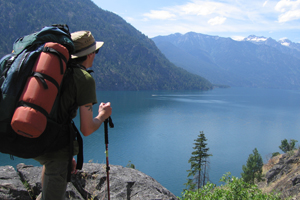
Story and Photos by Rebecca Agiewich
Photo at right: Dave Taylor surveys Lake Chelan on the Lakeshore Trail.
“The reason I like backpacking so much,” my dad once said to me, “is that you don’t have to think about anything except putting one foot in front of the other and what you’re going to eat for dinner.”
At age 12, and already a backpacking veteran, I thought he was crazy.
To me, the walking part was the least fun. The best part was chasing butterflies, playing cards in the tent with my sister, or fishing for rainbow trout in the sparkling high Sierra lakes where my family wandered.
I get it now, of course. As an adult, backpacking is one of my favorite escapes. And one of the great things about it is that that anyone can learn to do it at any age. No particular dexterity, coordination, or fearlessness required. Here are some tips to get you started.
Take a class, join a club, hike with others
Besides the ability to hike and carry a heavy pack, there are a few skills you should have before you hit the trail. The ability to navigate, a working knowledge of first aid, and an understanding of how to dress properly (no cotton!) will help you stay safe, comfortable, and ensure you have fun.
Luckily, you don’t have to learn this all on your own. In the hiking-happy Pacific Northwest, there are endless opportunities to learn basics from classes and organized outings. The Mountaineers, for example (with branches throughout western Washington), offers basic backpacking classes every spring, as well as backpacking trips throughout the year with experienced leaders.
Don’t fear bears but don’t tempt them (or other animals) either
Hike in the Pacific Northwest long enough and you’re likely to see a black bear sooner or later. And it will be one of the most exhilarating experiences of your life … after the fact, anyway, when you get to boast to all your friends about it.
The reality is, bears are shy and they don’t want a run-in with you. But you can minimize temptation for the bears—and especially for rodents—by storing your food properly, away from your camp. Store food in a lightweight locking canister (available in outdoor stores) or by hanging your food in a tree. This method is more time-consuming and tedious but doesn’t require any extra gear because you can use a stuff sack that you have on hand.
If you ever feel tempted to leave food in your tent overnight, ask me about the time I did that and a mouse chewed its way in at 2 a.m!
Pack lightweight, calorie-dense food
One of the best parts about backpacking is burning all those calories! Figure that on average you’ll need to eat about 3,000–4,500 calories a day with frequent snacking. How do you do it without making your pack weigh a ton?
Pack calorie-dense, lightweight foods that are tasty and nutritious. Dehydrated meals can make menu planning easier, especially for longer trips. Shop around for a brand you like and test them out at home—especially if you’re a picky eater. (Many avid backpackers eventually learn to dehydrate their own food.)
Nuts, chocolate, salami, hard-boiled eggs, and cheese and crackers are all favorite trail snacks of mine. Pasta at dinner and oatmeal at breakfast are also staples. On shorter trips, I often bring some fresh fruits and vegetables, too.
Meal-planning is still a challenge for me even after decades of backpacking (except for the eating thousands of calories per day part).
Take advantage of all the great resources listed at the end of this article to help you learn the art of packing for, and cooking on, the trail.
Pick a realistic destination for your first outing
There are so many amazing wilderness destinations in the Northwest, it can be hard to choose one. Peak-ringed lake?
Wildflower-studded meadow? Enchanted old-growth rainforest?
If it’s your first time out, keep your ambitions modest. Make your first day a short one of two-to four-miles so you can reach camp with confidence. Consider using the base-camp strategy, where you set up a “permanent” camp the first night and then day-hike from there on subsequent days (my own personal favorite way to backpack).
There are plenty of relatively easy, yet stunning, Northwest trails to test out your boots and new backpack. Once those boots are broken in and you feel you know the ropes a little, then it’s time to challenge yourself. Wonderland Trail anybody?
Get high-quality boots and socks
If you’re starting from scratch, the gear-accumulation phase of backpacking can be overwhelming—for both the mind and wallet. But keep in mind, many of the basics can be rented, including tents, backpacks, sleeping bags, and stoves.
The key thing is to get a good pair of backpacking boots (fitted by a professional). You’re likely to be carrying anywhere from 30 – 60 pounds on your back, and the boots need to support you as you carry all that weight over sometimes-rough terrain.
Though some experienced backpackers swear by light hiking boots, most of us need over-the-ankle support for comfortable backpacking. Err on the side of sturdier boots when you’re starting out, and try them on with a loaded pack at the store if you can. Then break them in around town before you hit the trail. And, don’t forget a spare pair of, comfy, moisture-wicking socks!
Lastly…Stay flexible and ready for anything
Like any good adventure, your first (or your 10th) backpacking trip probably won’t go exactly as planned. The heavens can open, gear can break, you can get lost. All of that has happened to me. But these misadventures often make the best stories! And there will be plenty of good surprises too: fields of purple lupine that stretch forever, more stars than you’ve ever seen in your life, and the joy of wading into a shimmering blue lake on an 80-degree day after shedding your heavy pack.
In the Northwest, with backpack at the ready, you don’t have to go very far to find all these wonders and so much more.
Resources
Classes and organized outings
The Mountaineers: offers classes and organized outings, including backpacking classes and backpacking cooking classes — www.mountaineers.org
Trails Club of Oregon: runs trips year round — www.trailsclub.org/event.html
Helpful websites
Washington Trail Association (WTA): has up-to-date trip reports on its Website to help you research your trip, as well as many useful articles, both online and in their magazine. www.wta.org/
Portland Hikers.org has resources and trip reports for hikes in Oregon and beyond: www.portlandhikers.org/
Seattle Backpackers Magazine: seattlebackpackersmagazine.com/
Green Trails Maps: www.GreenTrailsMaps.com
Delhorme: www.inreachdelorme.com
Books
Mountaineers Books offers a plethora of titles about where to hike and backpack in the Northwest (and elsewhere) and how to do it.
How-to books: www.mountaineersbooks.org/How-to-C1041.aspx
Where-to books: www.mountaineersbooks.org/Where-to-C1045.aspx
“Allen & Mike’s Really Cool Backpackin’ Book:” is written by two National Outdoor Leadership School (NOLS) instructors who provide lots of practical information in a fun way.
Rebecca Agiewich has been backpacking since age 8 and leads backpacking trips for the Seattle Mountaineers.

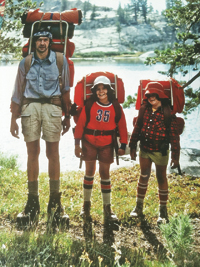
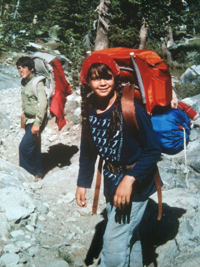
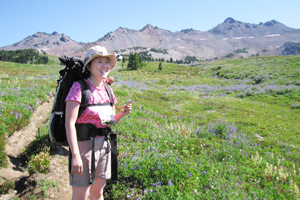
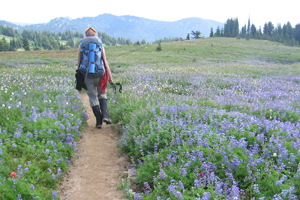
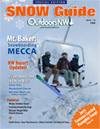
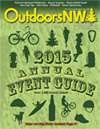
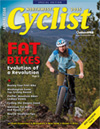
Greg, 1 year ago
Rebecca, this is an excellent article! Very entertaining.